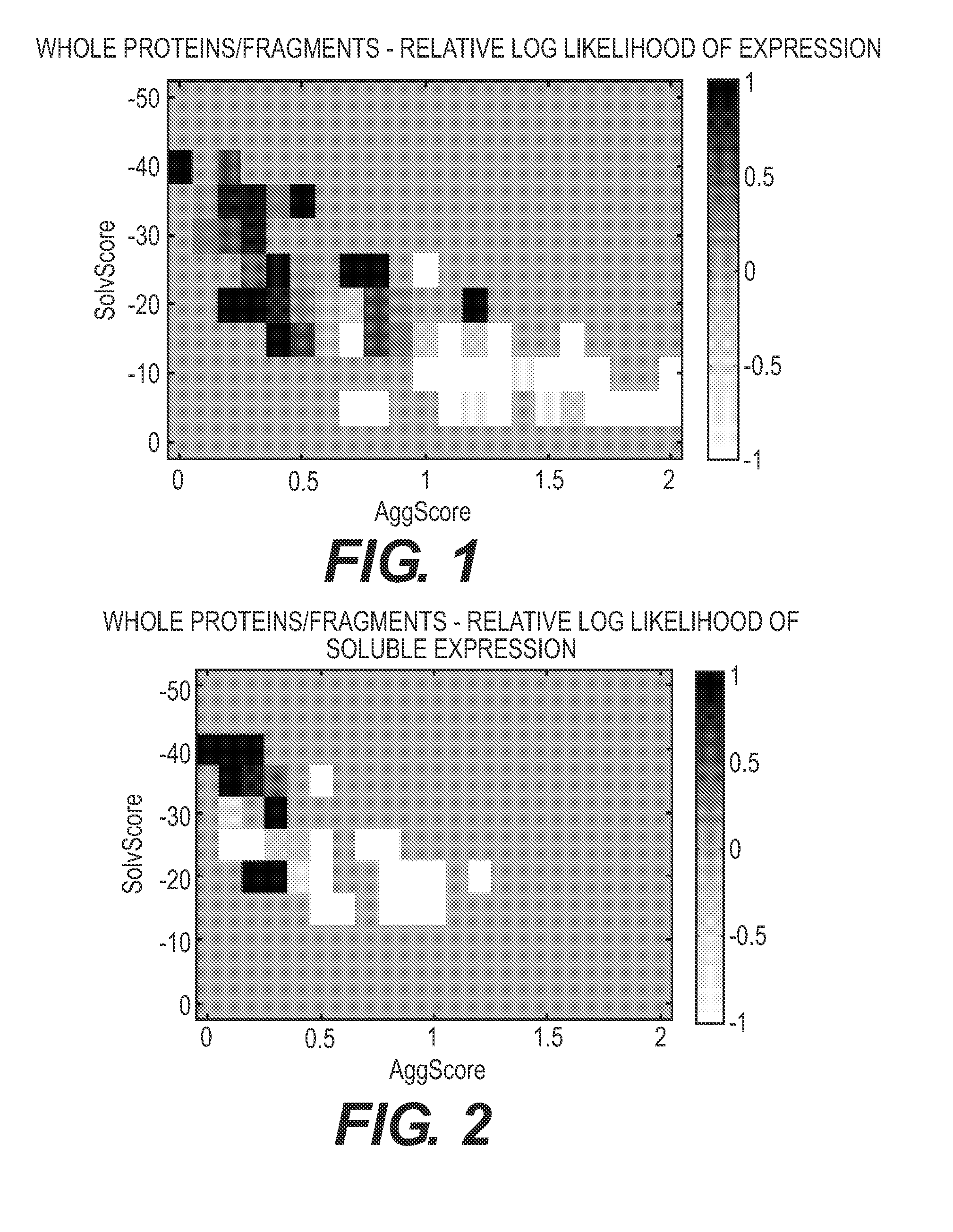Nutritive Fragments and Proteins with Low or No Phenylalanine and Methods
- Summary
- Abstract
- Description
- Claims
- Application Information
AI Technical Summary
Benefits of technology
Problems solved by technology
Method used
Image
Examples
example 1
Identification of Proteins and Protein Fragments Containing No Phe and Ratios of Essential Amino Acids, Branch Chain Amino Acids, and Leucine Greater Than or Equal to Whey
[0300]The UniProtKB / Swiss-Prot (a collaboration between the European Bioinformatics Institute and the Swiss Institute of Bioinformatics) is a manually curated and reviewed protein database, and was used as the starting point for protein identification. Proteins from the edible species Solanum lycopersicum, Zea mays, Oryza sativa subsp. Japonica, Glycine max, Ovis aries, Pisum sativum, Spinacia oleracea, Oryza sativa subsp. Indica, Triticum aestivum, Sus scrofa, Prunus persica, Capsicum annuum, Malus domestica, Thunnus albacares, Capra hircus, Cicer arietinum, Salmo salar, Meleagris gallopavo, Solanum tuberosum, and Agaricus bisporus having greater than or equal to fifty (50) amino acids were sampled as targets for this example. This provided a set of 8,415 proteins for evaluation. The amino acid content, percentage...
example 2
Identification of Proteins Containing No Phe and Ratios of Essential Amino Acids, Branch Chain Amino Acids, and Leucine Greater Than or Equal to Gelatin
[0302]The database of 8,415 proteins described in Example 1 was again screened. The amino acid content, percentage of essential amino acids (“EAA”), the percentage of branched chain amino acids (“BCAA”), the percentage of leucine (“L”), and whether the protein contained Phe was evaluated. The SolvScore was also calculated for each protein. In addition, the proteins were screened against a database of known allergens to determine whether any had greater than 50% global homology to a known allergen. A total of 21 proteins were identified that have a SolvScore of −20 or less and that contain greater than or equal to 19% EAA, greater than or equal to 8% BCAA, and greater than or equal to 4% Leu, and have less than 50% global homology to known allergens (SEQ ID NOS: 12 to 32). (These values were used to identify nutritive proteins of inte...
example 3
Protein Expression
[0304]Genes encoding nutritive proteins of this disclosure were codon optimized for expression in Escherichia coli and synthesized by either LifeTechnologies / GeneArt or DNA 2.0. Genes were designed to express the native protein or to contain one of two amino-terminal tags to facilitate purification:
(SEQ ID NO: 151)MGSHHHHHHHH(SEQ ID NO: 150)MGSSHHHHHHSSGLVPRGSH
[0305]These gene constructs were inserted into the pET15b plasmid vector (Novagen) using NcoI-BamHI restriction sites (in case of the first tag) or using the NdeI-BamHI restriction sites (in the case of the second tag). All restriction enzymes were purchased from New England Biolabs. Plasmids were transformed into Escherichia coli T7 Express (New England Biolabs) and selected on lysogeny broth (LB) plates containing 100 mg / l carbenicillin. A single colony was picked, grown to OD600 nm≈0.6 in LB with 100 mg / l carbencillin, and stored as a glycerol stock (in LB with 10% glycerol (v / v)) at −80° C., to serve as a...
PUM
| Property | Measurement | Unit |
|---|---|---|
| Fraction | aaaaa | aaaaa |
| Fraction | aaaaa | aaaaa |
| Fraction | aaaaa | aaaaa |
Abstract
Description
Claims
Application Information
 Login to View More
Login to View More - R&D
- Intellectual Property
- Life Sciences
- Materials
- Tech Scout
- Unparalleled Data Quality
- Higher Quality Content
- 60% Fewer Hallucinations
Browse by: Latest US Patents, China's latest patents, Technical Efficacy Thesaurus, Application Domain, Technology Topic, Popular Technical Reports.
© 2025 PatSnap. All rights reserved.Legal|Privacy policy|Modern Slavery Act Transparency Statement|Sitemap|About US| Contact US: help@patsnap.com


